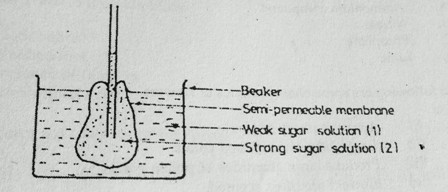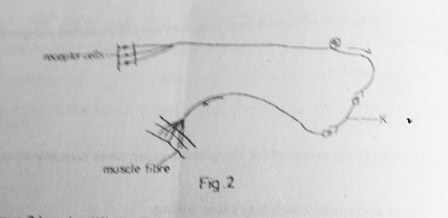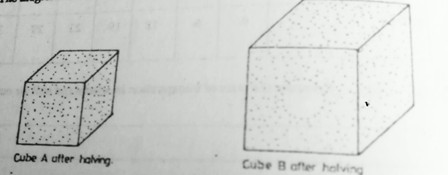PAPER 1
THEORY
SECTION A
Answer all questions in this section. For each question select the most correct option and shade the letter representing it in the answer sheet provided.
1. The following results were obtained from an experiment done to determine the percentage of air in a sample of soil.
Volume of water used = 10cm3
Volume of soil + water =40cm3
Volume of soil +water after stirring = 37cm3
From the results, the percentage of air in the soil is
A. 7.5
B. 8.1
C. 10
D. 23.3
2. Which one of the following flower parts is most important in promoting insect pollination?
A. Calyx
B. Corolla
C. Stamens
D. Pistil
3. Figure 1 shows an experiment which was set up and left to be observed the following day.

Which of the following events will have taken place?
i) Solution 2 will have risen higher in the capillary tube
ii) The level of solution.1 will have fallen
iii)The level of solution 2 in the capillary tube will have fallen
iv) Concentration of solution 1 in the beaker will not have changed at all
A. (i) and iii)
B. (ii) and (iv)
C. (i) and (ii)
D. (iii) and (iv)
4. 2g of a food substance was burnt and the heat produced raised the temperature of 50cm of water from 250C to 370C. What is the energy content of the food substance in joules per gram? (Specific heat capacity of water = 4.2j per gram)
A. 1260joules
B. 2520joules
C. 300 joules
D. 105 joules
5. Which one of the following activities takes place during the pupal stage in the life cycle of an insect?
A. Hibernation
B. Organ formation
C. Feeding
D. Resting
6. A couple produced four children who were of different blood groups with the following genotypes: AO, BO, AB and OO. What were the genotypes of their parents?
A. AA and OB
B. AO and OB
C. BB and OB
D. AB and OO
7. Which one of the following can be applied so as to reduce the acidity of a soil?
A. Ammonium compound
B. Nitrate
C. Phosphate
D. Lime
8. The following are some characteristics of flowers.
i) Large feathery stigma
ii) Large brightly coloured petals Produce large quantities of pollen grains
iii)Flowers are often scented
Which of the characteristics belong to wind pollinated flowers?
A. (i) and (ii)
B. (iii) and (iv)
C. (i) and (iii)
D. (i) and (iv)
9. The living together of a fungus and an alga as a lichen is called
A. Symbiosis
B. Parasitism
C. Saprophytism
D. Commensalism
10. Which one of the following seed parts both roles of protection and nutrition during germination?
A. Endosperm
B. Testa
C. Coleoriza
D. Cotyledons
11. Why is a shoot being prepared for transpiration experiments normally cut under water?
A. Avoid water loss which may cause wilting
B. Prevent loss of sap
C. Prevent air from entering the xylem vessels
D. Remove damaged tissue
12. Meiotic cell division important because it ensures that
A. there is variation in the number of chromosomes
B. the number of chromosomes of a species is not doubled at fertilisation
C. the chromosomes of the daughter cells are identical
D. bad traits are not passed on from parents to offspring
13. The following are features found in birds.
i) Light bones
ii) Webbed feet
iii)Presence of feathers
iv) Streamlined body
which of the features are adaptations for flight?
A. (i) and (ii)
B. (ii) and (iii)
C. (iii) and (iv)
D. (i) and (iv)
14. The following substances are secreted in mammalian sweat?
A. Urea, ammonia, water
B. Urea, carbon dioxide, sodium chloride
C. Urea, water, sodium chloride
D. Urea, carbon dioxide, water
15.
. 
Figure 2 is a simplified reflex arc. The labelled K is
A. The relay neurone
B. A ganglion
C. The sensory neurone
D. The motor neurone
16. Nerves, the spinal cord and the brain make up
A. a tissue
B. a system
C. an organ
D. an organism
17. Which one of the following shows the correct path followed by light ray to produce an image at the retina?
A. Cornea, aqueous humour, lens, pupil, vitreous humour, retina
B. Cornea , vitreous humour, pupil, lens, aqueous humour retina
C. Cornea, pupil, vitreous humour, lens aqueous humour, retina
D. Cornea, aqueous humour, pupil, lens, vitreous humour, retina
18. Decrease in the number of mammalian red blood cells could reduce the ability of the blood to
A. Clot
B. Transport oxygen
C. Destroy harmful bacteria
D. Distribute heat.
19. Which one of the following characters shows discontinuous variation?
A. Blood groups
B. Height
C. Intelligence
D. Skin colour in people
20. The similarity in feeding between an amoeba and the fungus Mucor is that both
A. Feed on dead organic matter only.
B. Ingest undigested food materials.
C. Digest their food within vacuoles.
D. Secrete enzymes onto food materials from their cytoplasm.
21. Which of the following make the skin of a toad an effective respiratory surface?
i) Moist surface
ii) Rough skin
iii) Rich blood supply to the skin
iv) Large numbers of secretory glands on the skin
A. (i) and (iii)
B. (i) and (ii)
C. (ii) and (iv)
D. (iii) and (iv)
22. Below are some food chains: which one of them is correct?
A. Dead wood - termite - chicken
B. Chameleon - mantis - grasshopper
C. Termite - hawk - snake
D. Carnivore - plant - herbivore
23. Which one of the following types of cells is unspecialised?
A. Companion cell in plants
B. Red blood cell
C. Meristematic cell
D. Nerve cell
24. During inspiration the
A. Pressure in the thoracic cavity is reduced.
B. External intercostals muscles relax
C. Diaphragm becomes dome shaped
D. The thoracic cavity becomes smaller
25. A hetozygous red flowered plant (Rr) is crossed with a homozygous white plant (rr); If R is dominant over r, what will be the phenotypes of the offspring?
A. All red.
B. All white
C. Pink and white
D. Red and white
26. Which one of the following is a characteristic of animal cells?
A. Presence of cell walls.
B. Cells consist entirely of cytoplasm.
C. Have regular shape.
D. Have large centrally placed vacuoles
27. Which one of the following dental formulae represents that of a ruminant (e.g. sheep)?
A. 2/2 : 1/1 : 2/2 : 3/3
B. 2/2 : 1/1 : 2/2 : 0/3
C. 0/2 : 1/1 : 2/2 : 3/3
D. 0/3 : 1/1 : 3/3 : 3/3
28. In plants, anaerobic respiration is less efficient than aerobic respiration because during an aerobic respiration
A. Not all the carbohydrates are broken down
B. The amount of carbon dioxide released is less than in aerobic respiration
C. There is less energy released per unit weight of carbohydrate broken down
D. Less water is produced in anaerobic respiration.
29. Which one of the following characteristics is common to birds, fish and reptiles?
A. Regulation of body temperature
B. Bodies are covered with scales
C. Use of nostrils for breathing
D. Internal fertilisation
30. Which of the following vitamins is deficient in a person whose gums bleed?
A. Vitamin C
B. Vitamin E
C. Vitamin B2
D. Vitamin K
SECTION B
Answer all questions in this section. Answers must be written in the spaces provided.
31. The table below shows the effect of wind, still air and stomata opening on the rate of transpiration of a plant in milligrams of water lost per hour per dm2. Study the table and answer the questions following.
| Stomata opening (pm) | 1 | 2 | 3 | 4 | 5 | 6 | 7 |
| Wind | 40 | 63 | 74 | 86 | 94 | 110 | 124 |
| Still air | 0 | 6 | 12 | 19 | 23 | 27 | 30 |
a) (i) Compare the rates of transpiration in windy and still air conditions.
(ii) Explain your observation.
b) How does stomata opening affect transpiration rate?
c) Name three other factors that affect the rate of transpiration.
d) State two functions of transpiration to plants.
32. Two different sized cubes of colourless jelly A and B were used to represent models of living organisms. They were submerged in a coloured dye for a period of time and then removed and cut into half.
The diagram below show the penetration of the dye

a) (i) Explain the difference between the penetrations of the coloured dye in the two cubes.
(ii) Suppose that the dye represents an essential substance being absorbed by a living organism. Explain how the problem in B could be overcome by a living organism without altering its shape.
b) Explain how the shape of a red blood cell helps it to function efficiently.
33. a) In cattle, the gene for horned bull. Using genetic symbols show the possible genotypes and phenotypes of the F1 offspring.
Genotypes of F1 offspring
...............................................................................................................
Phenotype(s) of F1 offspring
...............................................................................................................
b)(i) a bull whose horns were removed was mated to a horned cow. Show the possible genotypes and phenotypes of the F1 offspring.
Genotypes of F1 offspring
...............................................................................................................
Phenotype of F1 offspring
...............................................................................................................
(ii) Give a reason for your answer in (b)(i) above.
34. a) (i) Give the main difference between cold blooded (ectothermic) and warm blooded (endothermic) animals.
(ii) Give one advantage that an endothermic animal has over an ectothermic animal.
(iii) Why are ecothermic animals said to be cold blooded?
b) Give four ways in which an ectoderm reacts to the lowering of external temperature.
SECTION C
Answer any two questions from this section.
35. a) (i) what are the similarity (ies) and differences between asexual and sexual reproduction in the spirogyra?
(ii) What is the advantage of asexual reproduction to such a plant?
b) Describe sexual reproduction in the spirogyra.
36. a) Describe the digestion of proteins in the human alimentary canal.
b) What may happen to the products of digestion of proteins?
37. Explain how a dicotyledonous leaf is adapted for the process of photosynthesis.
38. a) Give six features which are common to adult insects.
b) (i)What is understood by the term metamorphosis?
(ii) With the aid of labelled diagrams, give an account of the life cycle of a house fly.
